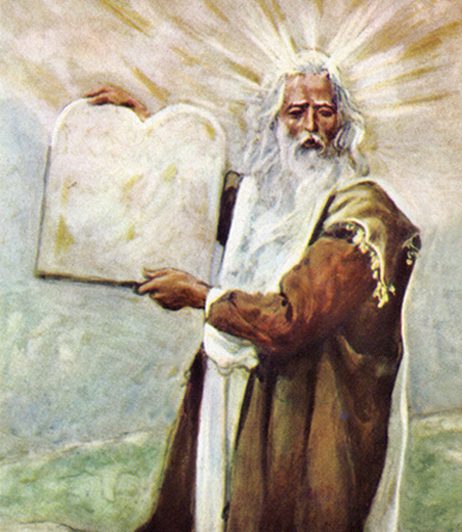
Atheist and anti-theist Bob Seidensticker runs the influential Cross Examined blog. He asked me there, on 8-11-18: “I’ve got 1000+ posts here attacking your worldview. You just going to let that stand? Or could you present a helpful new perspective that I’ve ignored on one or two of those posts?” He also made a general statement on 6-22-17: “In this blog, I’ve responded to many Christian arguments . . . Christians’ arguments are easy to refute.” He added in the combox: “If I’ve misunderstood the Christian position or Christian arguments, point that out. Show me where I’ve mischaracterized them.” I’m always one to oblige people’s wishes if I am able, so I decided to do a series of posts in reply.
It’s also been said, “be careful what you wish for.” If Bob responds to this post, and makes me aware of it, his reply will be added to the end along with my counter-reply. If you don’t see that at the end, rest assured that he either hasn’t replied, or didn’t inform me that he did. But don’t hold your breath. On 8-24-18 Bob wrote (after having virtually begged to dialogue with me back in May) that my alleged “disinterest in the truth reflects poorly” on me. What are we to make, then, of his utter “disinterest” in defending his opinions against serious critique?
Bob’s words will be in blue. To find these posts, word-search “Seidensticker” on my atheist page or in my sidebar search (near the top).
*****
This is one of the most bizarre and desperate of a long string of vapid anti-Christian arguments from Bob that I’ve critiqued. He opines in his post, “Atheist Monument Critique: Ten Commandments and Ten Punishments” (9-18-13; rev. 1-26-17):
The other Ten Commandments
. . . Let’s review the story. Moses gets the Ten Commandments on Mt. Sinai in Exodus 20, but the anxious Israelites make a golden calf during his long absence. When Moses sees this, he’s furious and smashes the tablets of the law. He gets a new set in Exodus 34. At the conclusion of this list, we read:
And [Moses] wrote on the tablets the words of the covenant—the Ten Commandments (Exodus 34:28).
This is the first time the phrase “Ten Commandments” is used in the Bible, and this version of the law was placed in the Ark of the Covenant. It couldn’t be the other set, since it was destroyed. But this law bears only a vague similarity to the set popularly portrayed as the Ten Commandments: make no covenants with the Canaanites (#1), God gets all firstborn (#5), never boil a young goat in its mother’s milk (#10). Read them yourself.
He links in his last three words to another article: “The Irrelevant Wisdom of the Ten Commandments” (3-9-12; rev. 2-14-14), where he pontificates in elaboration:
Moses goes up Sinai a second time in Exodus 34. God says, “I will write on the tablets the words that were on the former tablets which you shattered,” so we know that this nothing new, just a replacement set of commandments. But the contents are very different:
- Make no covenant with the Canaanite tribes
- Destroy their altars
- Make no idols (“molten gods”)
- Observe the Feast of Unleavened Bread
- “The first offspring from every womb belongs to me”
- Rest on the seventh day
- Celebrate the Feast of Weeks
- No leavened bread during Passover
- Bring the first fruits of the soil to the Lord
- “You shall not boil a young goat in its mother’s milk”
*
The chapter ends with these words: “And [Moses] wrote on the tablets the words of the covenant, the Ten Commandments.” This is the first time this label is used in the Bible.
You want to display the Ten Commandments in public? Go for it, but put up this list. It’s the official list, after all. These are the ten that wound up in the Ark of the Covenant.
Contrast this with the story of the first tablets, which concludes at the end of chapter 31, “[God] gave Moses the two tablets of the testimony, tablets of stone, written by the finger of God.” There is no mention of a “ten commandments,” and these stone tablets presumably contain all of the rules given in chapters 20 through 31.
False conclusions always flow from false premises somewhere along the line. The key fallacies that lead Bob on to his misguided and false conclusion are two:
1) Being overly concerned with what the two tablets written by the hand of God are called: i.e., “ten commandments”: which title first appears in Exodus 34:28.
2) Equating various instructions given by God to Moses with the second set of tablets.
I shall now explain these factors in detail. Bob himself gives us all the answers we need to refute his own claim (if we look close enough). Bob refers in the above excepts (including Bible quotes) to “tablets” or “two tablets” or “tablets of stone” no less than nine times. Thus, it is beyond dispute that this is what were talking about.
Now, it’s quite true that they are first referred to as “ten commandments” in Exodus 34:28 (and again, in Deut 4:13 and 10:4), but it doesn’t logically follow that the later use of that title, in referring to the tablets, means that something other than these tablets is being referred to. Nor does it prove that the tablets may not have been referred to earlier by that title.
All it proves is that this is the first time in the Bible that the name, “ten commandments” is applied to the stone tablets (and recorded). It’s easy to show that the application is to the aforementioned tablets (of which there were two sets, with the same content).
In summary, simply appealing to the use of the description / title “ten commandments” in Exodus 34:28, which occurred only after the second set was written by God, proves nothing in and of itself. It’s the biblical use of “tablets” that identifies what we are talking about.
Bob doesn’t say what Bible version he is citing. RSV, which is my first choice, uses the word, tables for tablets. The words, tables or tables of stone or tables of the testimony or tables of the covenant are used 31 times in Exodus and Deuteronomy: all referring to these two rock plates: upon which were written what was eventually to be known as the Ten Commandments.
But Bob’s weak argument claims that the first set of Ten Commandments wasn’t actually that because there was “no mention of a ‘ten commandments’,” while the second replacement set was indeed the Ten Commandments and “the official list” because, well, “This is the first time this label is used in the Bible” and because these were “the ten that wound up in the Ark of the Covenant.”
That argument is frivolous and can be dismissed without further comment. The claim that the content is different in the second set of tablets is at least more interesting and slightly stronger. But he refutes it himself by conceding that the second set was the same as the first set, and “nothing new” (“God says, “I will write on the tablets the words that were on the former tablets which you shattered,” so we know that this nothing new, just a replacement set of commandments.”) One would think that would settle it, but Bob immediately contradicts it in his next sentence: “But the contents are very different.”
Huh??!! How can the same “words that were on the former tablets” be on the second set of tablets, yet with different “contents”? Only Bob can explain such a logical absurdity that he sets forth for his readers How does Bob come up with this supposedly different content in the second set of Ten Commandments? He does so by confusing other laws and ordinances that God gave to Moses, with the Ten Commandments themselves.
The Bible states that the Ten Commandments were written by God Himself (first set: Ex 31:18; 32:16; Deut 9:10 / second set: 34:1, 28; Deut 10:1-4). Moses also wrote down various other laws given to him by God (Ex 24:4). These many other laws take up many chapters in both Exodus and Deuteronomy, and Bob refers to them (“rules given in chapters 20 through 31″). But his argument becomes ridiculous again by claiming that “these stone tablets presumably contain all of the rules given in chapters 20 through 31.”
This is contradicted by the inconvenient fact — noted right in the middle of all these enumerated laws in chapters 20-31 –, that “Moses wrote all the words of the LORD” (Ex 24:4). Two stone tablets (able to be held in Moses’ hands) could not possibly contain all the text of chapters 20-31. That is patently absurd. Yet here is Bob stating it.
God plainly states in Exodus 34:1: “Cut two tables of stone like the first; and I will write upon the tables the words that were on the first tables, which you broke.” The contents are exactly the same. Yet Bob claims that the Bible supposedly teaches that the first set of tablets contained all of Exodus 20-31: which add up to about 9900 words (minus portions of those chapters that are not just laws): all written on two tablets that Moses could carry in his hands. It’s ridiculous to call a supposed written record of almost 10,000 words “The Ten Commandments” in the first place.
Bob arbitrarily argues that the second tablets contain much of what we see in Exodus 34, because “ten commandments” is first used there in verse 28. He agrees that the first set were written by God, but he mistakenly thinks that the second two tablets were written by Moses, based on an erroneous reading of that same verse, that uses “he” referring to God, not Moses.
Exodus 34:1 (that was quoted by Bob) stated clearly that God wrote the words on the second set, just as He had with the first. Deuteronomy 10:1-4 reiterates this. Yet Bob interprets Exodus 34:28 as Moses writing on the tablets. Lousy exegesis again; these are silly, elementary mistakes.
The text never identifies the laws in Exodus 34 as the “ten commandments” themselves. When God gave Moses the Ten Commandments, as recorded in Exodus 20, there were a lot of other laws that Moses wrote down, given to him at the same time. God wrote the Ten Commandments down. It’s the same in Exodus 34: many other laws are also mentioned. It doesn’t follow that they are the Ten Commandments. They are more laws, similar to the ones referred to by Bob as “rules given in chapters 20 through 31.”
Bob tries to come up with ten “alt-laws,” so as to have a supposed “new set” (indeed, the “official list”: so says Bob) that was — we are told — different from the first. But his ten are completely arbitrary. If he’s gonna play the game of making Exodus 34 a new set, he has to record all of the laws mentioned, which are clearly more than ten. He can’t pick and choose (with a blindfold on). And this becomes another fatal flaw in his already very weak case. Here are the laws mentioned that his list of ten somehow overlooked:
34:22 And you shall observe the feast of weeks, the first fruits of wheat harvest, and the feast of ingathering at the year’s end.
Bob included only the feast of weeks, but the feast of ingathering (or tabernacles or booths) is a separate feast (see 23:16; Lev 23:34, 42; Deut 16:13, 16; 31:10, etc.). So that is Ten Commandment #11.
34:23 Three times in the year shall all your males appear before the LORD God, the God of Israel.
Hey, it’s another command or law, ain’t it? Why did Bob pass it over, I wonder? It’s Ten Commandment #12.
34:25 . . . neither shall the sacrifice of the feast of the passover be left until the morning.
Here Bob (oddly) makes the first part of the verse one of the (alt-) Ten Commandments, but not the second part. I wonder: what is his criterion for inclusion? It’s all the more odd and arbitrary because the very next verse also has two parts: both of which he considers part of the New Ten. Go figure. So now we’re up to Ten Commandment #13.
34:14 (for you shall worship no other god, for the LORD, whose name is Jealous, is a jealous God),
It’s ultra-odd that Bob decided to pass over this command, while retaining the one about idols, seeing that the real Ten Commandments mentions both things: prohibition of other gods (20:3) and of idolatry (20:4-5). Now we have Ten Commandment #14.
I think, by this point, his case collapses of its own weight. It’s a house of cards. This casts no doubt on the biblical text or time-honored understanding of the Ten Commandments at all, but it casts considerable doubt on Bob’s logical acumen and any alleged shred of fairness on his part towards the Bible and Judaism and Christianity.
***
Photo credit: Moses and the Ten Commandments (portion), by James Jacques Joseph Tissot (1836-1902) [public domain / Wikimedia Commons]
***













